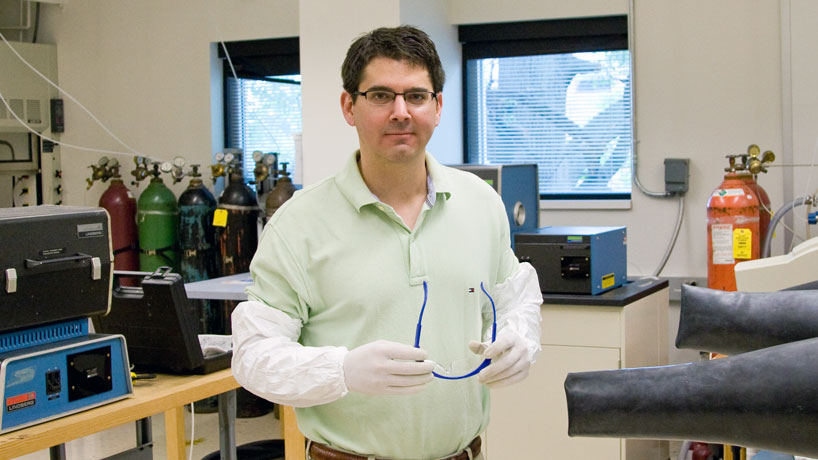
Physics Professor Eric Majzoub is part of the upcoming energy panel discussion at SLINN 2015, hosted by UMSL’s Center for Nanoscience on Dec. 12. He’s an expert on energy storage and conversion. (Photo by August Jennewein)
The opportunity to solve problems attracted Eric Majzoub to materials physics. With so many everyday applications, from the structure of buildings to smartphone screens to computer processing units, he understood the impact such research could have on modern society.
Majzoub is contributing to that advancement with work specifically in the renewable energy field. As a professor of physics and astronomy at the University of Missouri–St. Louis, he studies the design of new materials for energy storage and conversion.
 His expertise has landed him a spot in an upcoming energy panel discussion at the 2015 St. Louis Institute of Nanoscience and Nanomedicine Symposium. UMSL’s Center for Nanoscience, of which Majzoub is associate director, is hosting the event Dec. 12 in the Millennium Student Center.
His expertise has landed him a spot in an upcoming energy panel discussion at the 2015 St. Louis Institute of Nanoscience and Nanomedicine Symposium. UMSL’s Center for Nanoscience, of which Majzoub is associate director, is hosting the event Dec. 12 in the Millennium Student Center.
Get a sneak preview into Majzoub’s take on renewable energy, crystal structures and alternative fuels for cars here.
Without giving too much away, what will you be discussing as part of the SLINN 2015 energy panel?
The problems we face with an ever-growing world population are very difficult for a single principle investigator to solve. The trend in federal funding is to form larger consortia of researchers and research groups to tackle big problems. The energy arena in particular has problems that require large-scale solutions. We will discuss the overlapping research goals and how to form regional consortia during the panel discussion.
Why did you choose to go into the renewable energy field?
Global warming is now front and center in the news, with anthropogenic climate change largely due to our burning of fossil fuels and the release of carbon dioxide to the atmosphere. If we are to circumvent our need for fossil fuels for transportation and energy, we need to develop other technologies and sources of energy harvesting (solar, for example). Transportation in particular is an energy hog, and a difficult problem to solve without using petroleum.
The U.S. burns more than 400 million gallons of gasoline daily for automobile transportation. Each gallon of gas burned produces about 20 pounds of carbon dioxide that the atmosphere and oceans must absorb. The work in my research group is largely focused on energy storage materials including batteries, and hydrogen storage, ostensibly for fuel cell and hybrid electric vehicles. The U.S. Department of Energy is currently funding two projects in our group related to hydrogen storage materials. We hope to develop the technologies for carbon free transportation as soon as possible.
I understand your research focuses on crystal structures. What are they, and why are they important?
Crystal structures determine the arrangement of atoms in a solid. Studying them is one of the primary ways that we can gain an understanding of material behavior such as electronic, thermodynamic and structural properties (e.g. conductivity and heat capacity). The materials we study for hydrogen storage include ionic molecular salts like sodium aluminum hydride, NaAlH4. Knowledge of the structure of the solid helps in understanding the complex structural transformations that result when hydrogen is removed and solid-state reactions occur.
Why is NaAlH4 special? And what have we discovered about its ability to store and convert energy?
NaAlH4 is special because it can reversibly desorb and absorb hydrogen at temperatures of about 100 degrees Celsius, the operating temperature for the type of fuel cell desired for automobile transportation. In addition, it has relatively rapid absorption, which means one could ‘fill up’ at the fueling station fairly quickly. In this regard it is hard to beat gasoline, which requires only a few minutes to fill at the station.
We have discovered many so-called complex hydrides in the class of materials similar to sodium alanate (another name for NaAlH4). Many of these materials contain a lot of hydrogen relative to the total weight of the compound. The weight of the material is an important metric, with lighter materials favored for their better overall mileage efficiency.















